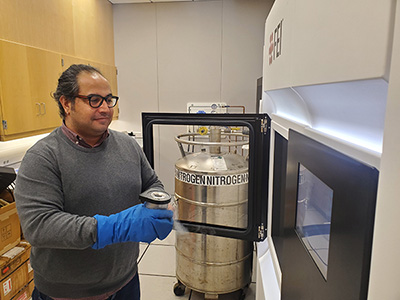Ecosystem for Research Networking develops platform for remote scientific instrument control

Staff Scientist Emre Firlar loads cryopreserved specimens into the electron microscope at the Rutgers Cryo-EM & Nanoimaging Facility.
The Ecosystem for Research Networking (ERN), a team consisting of members from Rutgers University, MGHPCC, Omnibond, Virginia Tech, UMass Amherst, Penn State University and Pegasus, is developing a way to use scientific instruments remotely online. The project seeks to improve access to high-cost, specialized equipment to advance national research initiatives.
The ERN Cryo-EM Federated Instrument Pilot Project, in partnership with Rutgers University, is creating a portal that enables the remote control of cryo-electron microscopes and analysis of electron microscopy data. ERN is developing the portal by building upon the Ohio Supercomputer Center’s (OSC) remote high performance computing (HPC) platform, Open OnDemand.
Cryo-electron microscopy (Cryo-EM) is quickly gaining popularity within the biochemistry community as the method of choice for structural biology, due to its unique abilities and extreme resolution. Creating a portal for remote Cryo-EM operation and analysis will remove cost and geographic restrictions for more researchers around the world, connecting them to the tools they need to advance scientific knowledge.
“The motivating factor within this project is coming up with a solution that allows us to address the democratization of access to research instruments that can be duplicated across multiple universities and across the nation,” said J. Barr von Oehsen, associate vice president of the Office of Advanced Research Computing at Rutgers University.
Cryo-EM instruments collect images of samples preserved in a state of water called vitreous ice, which is translucent to electrons. The microscope then uses electrons to image samples down to a fraction of a nanometer. This technique allows scientists to view organic matter in its natural environment with extreme precision, said Jason T. Kaelber, director of the Rutgers Cryo-EM & Nanoimaging Facility.
Due to the enormous amounts of data collected by the instrument, much of the processing needs to be outsourced to high performance computing clusters. The new portal allows for this data to be processed in real time using a closed-loop system between remote operator, instrument and off-site HPC cluster. This real-time analysis allows for more accurate data extraction and increased efficiency.
“The idea of our closed-loop system is that as your experiment happens, the data analysis is happening simultaneously so that you can change any settings that you need to on the spot,” Kaelber said. “We are leveraging Open OnDemand in the context of this portal to create a workflow and user experience where every user can access all the tools they need.”
Creating a capable yet easy-to-use portal presented a significant challenge. Open OnDemand provided an efficient starting point for the portal’s development because of its recognition within the research community, robust security measures and adaptability.
As Open OnDemand is a popular technology for remote HPC computing, used at nearly 500 sites around the world, on all continents except Antarctica, the team hopes that the research community will find it easy to use the new portal.
“Open OnDemand is an interface that a lot of researchers are familiar with, which made it an obvious choice for our interface,” von Oehsen said.
Open OnDemand’s reliance on security processes inherited from the underlying operating system also provided an easy starting point for the development of federated access, a method of secure authentication where the portal can incorporate institutions’ native logins to identify users and grant them access. Without federated access, each user needs to get a separate account at every institution where they access instruments.
In addition, Open OnDemand’s flexibility allowed the team to create a portal that is easily customizable, allowing other instruments to be swapped in with ease, said Morgan Ludwig, TechSquare Open OnDemand specialist at MGHPCC.
At the Supercomputing Conference 2022 (SC22), the ERN team presented a demonstration in which the portal was used to connect to an ion beam, cutting an image into a small silicon wafer over a wireless connection.
“It took significant effort to get the portal working in the way we wanted it to, and so when we were able to add the ion beam with ease it was very exciting,” said Maureen Dougherty, ERN Cryo-EM Federated Instrument Pilot Project lead.
Since its inception, ERN has worked to make the portal a community tool for building collaborative science. Many institutions have already expressed interest in developing and using the portal within their research environments.
“The idea was to package up the portal in a way that makes it as easy as possible to deploy at any institution with an instrument they would like to share,” Ludwig said.
In Phase 1 of the project ERN completed the base structure for the platform that will be built upon moving forward. ERN is currently collaborating with numerous institutions and software providers to receive feedback, expand functionality and begin implementing their technology within the research community.
By Kiah Easton